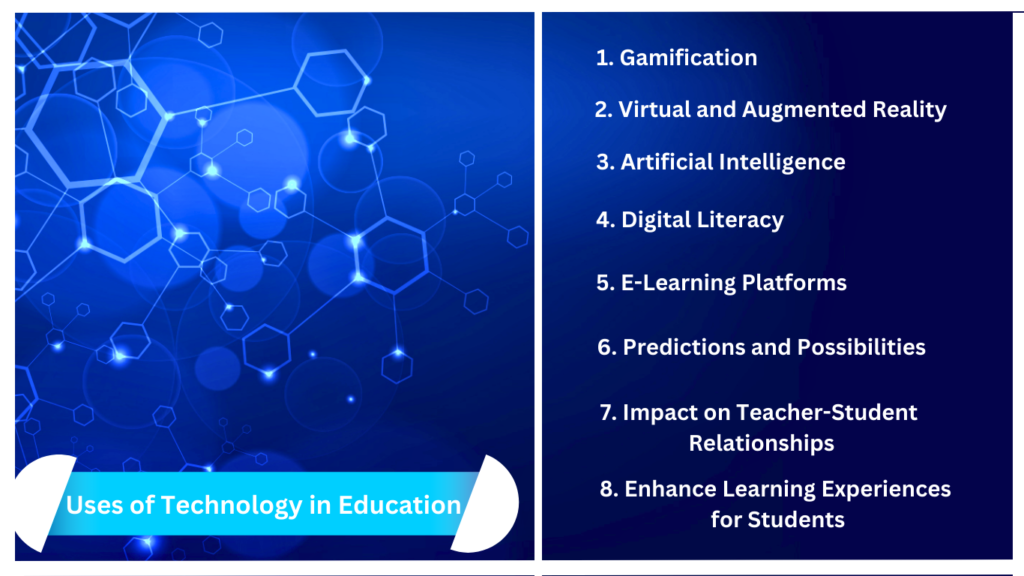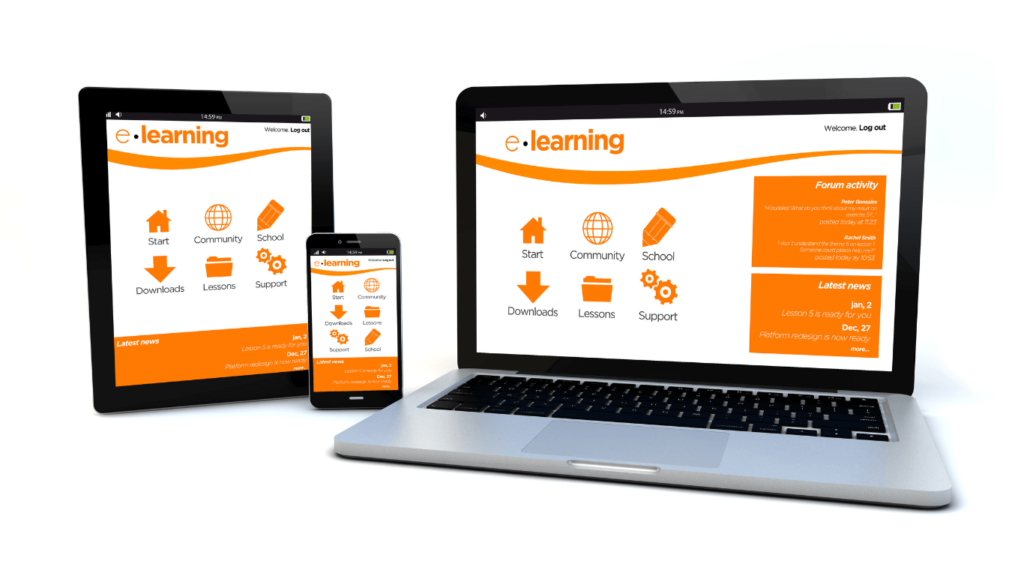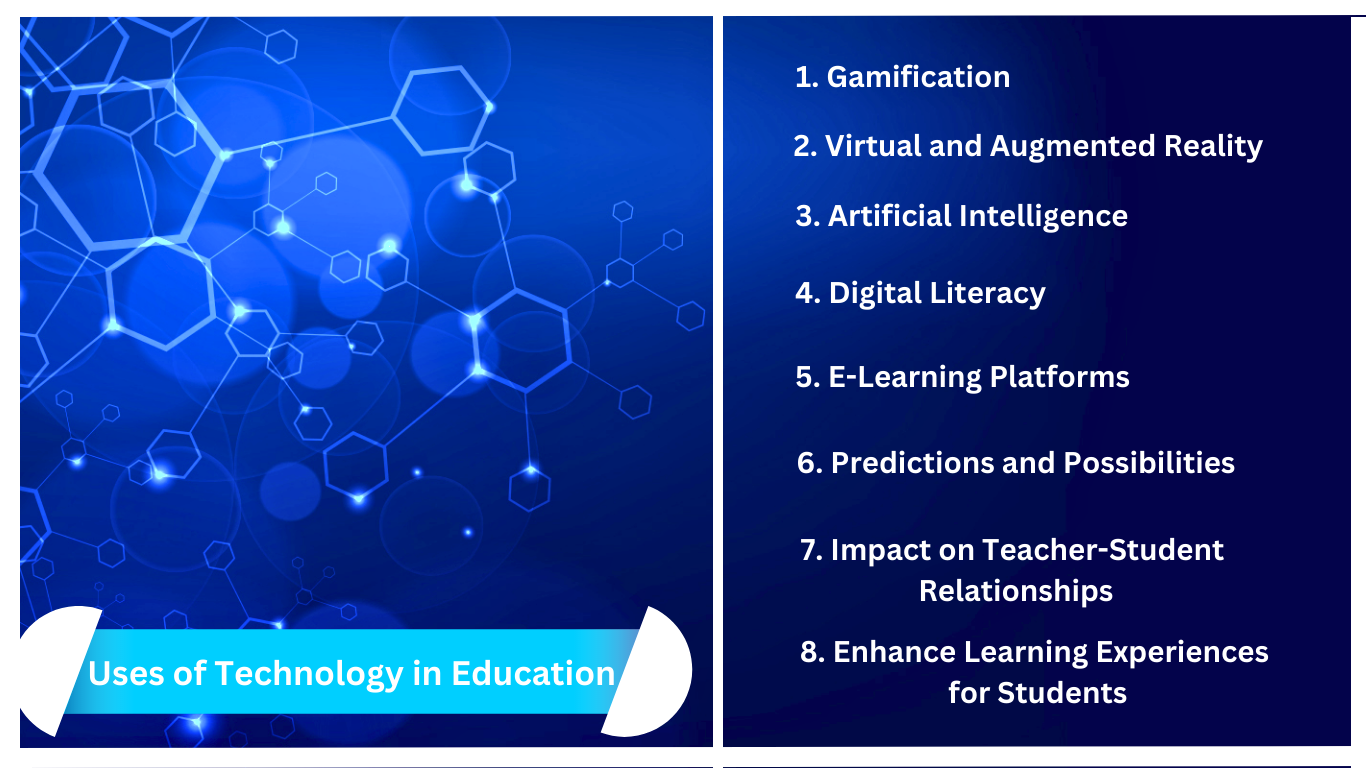Hey! Do you want to know “Uses of Technology in Education”, then follow this article.
Advantages and Disadvantages of the Internet

As technology continues to advance and change the world we live in, it has also had a significant impact on education. From gamification to e-learning platforms, technology has transformed the way we learn and has opened up new possibilities for education.
In this article, I will explore the uses of technology in education, the benefits and challenges, and the future of learning.
Use of Technology in Education
1. Gamification
Gamification has become an increasingly popular method of engaging students in the learning process. By incorporating game elements into education, such as points, badges, and levels, students are motivated to learn and are rewarded for their efforts.
Gamification also provides a sense of competition and social interaction, which can enhance the learning experience.One example of gamification in education is Duolingo, a language learning app that uses game-like elements to engage users.
The app uses a point system to track progress and offers rewards for completing lessons. This approach has proven to be effective, as Duo lingo has over 300 million users worldwide.

However, there are also concerns with gamification in education. Critics argue that it can create a superficial understanding of the material and may not be suitable for all learners.
It is important to use gamification in moderation and to ensure that it is aligned with educational goals.
2. Virtual and Augmented Reality
Virtual and augmented reality are emerging technologies that have the potential to revolutionize education. By creating immersive environments, students can experience real-world situations and scenarios, enhancing their understanding and engagement.
For example, medical students can use VR to simulate surgeries and procedures, allowing them to practice and refine their skills without the risk of harm to patients. History students can use AR to explore historical sites and artifacts, bringing history to life in a new and exciting way.
However, the cost of VR and AR technology can be a barrier to implementation, and there are concerns about the potential for addiction and over-reliance on technology.
3. Artificial Intelligence
Artificial intelligence (AI) has the potential to personalize the learning experience for students. By analyzing data on student performance and behavior, AI can provide tailored recommendations for learning and identify areas where students may need additional support.
For example, AI can analyze a student’s writing and provide feedback on grammar and structure, helping them improve their writing skills. AI can also provide personalized learning paths based on a student’s strengths and weaknesses, allowing them to progress at their own pace.
However, there are also concerns about the potential for AI to replace teachers and the need to ensure that AI is used ethically and responsibly.
4. Digital Literacy
As technology becomes increasingly integrated into education, it is important for students to develop digital literacy skills. Digital literacy involves the ability to use technology effectively and responsibly, including skills such as online research, communication, and data analysis.
By developing digital literacy skills, students are better equipped to navigate the digital world and can take advantage of the opportunities that technology provides.
5. E-Learning Platforms
E-learning platforms, such as Coursera and edX, provide access to high-quality educational content from top universities around the world. These platforms allow students to learn at their own pace and on their own schedule, making education more accessible and flexible.

E-learning platforms also provide opportunities for lifelong learning and can help individuals develop new skills and knowledge throughout their lives.
6. Predictions and Possibilities
As technology continues to advance, the possibilities for education are endless. One prediction is that personalized learning will become more widespread, with AI providing tailored recommendations and learning paths for students.
Another possibility is the use of blockchain technology to verify student credentials and provide a more secure and transparent system for accreditation.
Finally, there is the potential for technology to create a more collaborative and globalized learning experience, connecting students and teachers from around the world.
7. Impact on Teacher-Student Relationships
Technology has the potential to enhance teacher-student relationships, by providing new ways to communicate and collaborate. For example, teachers can use online platforms to provide feedback and support to students, and students can collaborate on projects using online tools.
However, there is also the concern that technology may create a distance between teachers and students, as face-to-face interaction is reduced. It is important to find a balance between technology and traditional teaching methods, to ensure that teacher-student relationships are maintained.
8. Enhance Learning Experiences for Students
Technology can enhance learning experiences for students in a number of ways. By providing access to high-quality educational content, personalized learning paths, and immersive environments, students can engage with material in a more meaningful and effective way.
Technology can also provide opportunities for collaboration and social interaction, allowing students to learn from each other and work together on projects.
Conclusion – Uses of Technology in Education
As technology continues to transform education, it is important to remember that it is a tool to support teachers and students, not replace them. By using technology responsibly and ethically, we can create a more accessible, engaging, and effective learning experience for all.
The potential of technology in education is vast, and we are only beginning to scratch the surface of what is possible. By embracing new technologies and finding innovative ways to use them, we can create a brighter future for education and for the students who will shape it.
So that’s all about “Uses of Technology in Education“.

